Published by: Diana Luai Awad, Dr Pharmacist
Hemolytic anemia (HA) is a large group of diseases. They were first written about in 1871 by C.F. Vanlair and J.B. Masius. The term was proposed by W. Hunter in 1901.1,2
They are characterized by:
- accelerated erythrocytes breakdown (hemolysis):
- shortening their lifespan (up to 2-3 weeks instead of 3-4 months);
- increase in the amount of breakdown products of red blood cells;
- reactive enhancement of erythropoiesis.
All these signs are extremely important and play a key role in clinical manifestations, in diagnosis and treatment.

Classification
As we already mentioned in the first part of the set of articles, according to one of the classifications of anemia, they can be divided based on the following parameters:
- According to MCH (mean corpuscular hemoglobin):
- Hypochromic <27 pg;
- Normochromic 27-32 pg;
- Hyperchromic > 32 pg.
- According to MCHC (mean corpuscular hemoglobin concentration):
- Hypochromic <320 g/dl;
- Normochromic 320-360 g/dl;
- Hyperchromic > 360 g/dl. [one]
Mostly, hemolytic anemias are of the normochromic type.
There are two large groups of hemolytic anemias:
- Hereditary (arise due to congenital anomalies in the erythrocyte itself).
- Acquired.
Table 1. Etiologic classification of hemolytic anemia
|
Hereditary3 |
|
|
erythrocyte membrane or membranopathies destruction |
are divided into two subtypes: • associated with the structure of erythrocyte membrane proteins: ovalocytosis, microspherocytosis, pyropoykylocytosis, stomatocytosis, Rh-null disease; • there are erythrocyte membrane lipids abnormlities: acanthocytosis. |
|
erythrocyte enzyme deficiencies |
• glucose-6-phosphate dehydrogenase; • pyruvate kinase; • enzymes of the pentose phosphate cycle; • glutathione; • enzymes involved in the metabolism of ATP, the formation of porphyrins. |
|
abnormal formation or structure of hemoglobin |
· thalassemia; · HA caused by abnormal primary structure in hemoglobin - sickle cell anemia. |
|
Acquired (arise due to various internal and external causes). They are divided into 4 subclasses:4 |
|
|
Immunohemolytic |
· autoimmune (antibodies are produced against their own unchanged red blood cells) · isoimmune (hemolysis occurs in newborns incompatible with the mother according to the AB0 system or Rh factor, as well as when incompatible blood is transfused) · heteroimmune (antibodies to one's own red blood cells appear while taking certain drugs). |
|
Membranopathy |
· Marchiafava-Micheli's disease or paroxysmal nocturnal hemoglobinuria (results from a myelopoiesis precursor cell mutation, various physiological factors, including sleep, provoke hemolysis); · spur cell anemia (cause is not fully understood, occurs in patients with cirrhosis of the liver). |
|
HA caused by mechanical damage to erythrocytes |
· microangiopathic HA or Moshkovich's disease: develops with systemic damage to small vessels by immune complexes, in which hemolysis occurs subsequently; · marching HA: hemolysis in the vessels of the lower extremities, which are in rigid contact with a hard surface when running, marching, etc.); · HA, which develops with prosthetic blood vessels or heart valves |
|
Toxic HA |
Hemolysis can be provoked by: · infectious toxins of salmonella, meningococci, clostridia, pneumococci, hemolytic streptococci, etc.; · chemicals: acetic acid, heavy metals, toluene, pesticides, poisons of mushrooms, snakes, spiders, aniline, etc.; · drugs: quinidine, some antibacterial agents, sulfonamides, pyryramidone, etc. |
In addition, hemolysis is divided into intracellular and intravascular, based on development and localization mechanism. It can occur continuously or episodically (crises).2
Table 2. Differences between intracellular and intravascular hemolysis 8
|
|
Intracellular |
Intravascular |
|
Where does erythrocyte destruction take place? |
In reticuloendothelial system macrophages (mostly in the vascular sinuses of the spleen) |
Directly within the vascular bed, and erythrocytes contents enter the blood directly. |
|
How is hemoglobin split? |
Hemoglobin is broken down into globin protein and heme. |
Free hemoglobin in blood. |
|
How are breakdown products removed? |
Globin breaks down into amino acids and is used for the body needs. Heme breaks down into protoporphyrin and iron. Protoporphyrin is converted to indirect bilirubin, which binds in the liver and is then excreted from the body in the feces as stercobilinogen, and also in the urine as urobilinogen. Iron is recycled and used for the body needs. |
When hemolysis is moderate, free hemoglobin is bound by haptoglobin, the resulting hemoglobin + haptoglobin complex is subsequently excreted by macrophages of the reticuloendothelial system. With severe hemolysis, hemoglobin is excreted by the kidneys and hemoglobinuria is determined in the clinical analysis of urine. |
HA pathogenesis
Depending on a causative factor, HA pathogenesis will differ and develop along its own path. But in the end, hemolysis will be at the heart of every nosology. Within the framework of this article, we present the general principle of erythrocyte lysis. It proceeds in stages:
- Abnormal permeability of erythrocyte membranes;
- Increased permeability to sodium ions, organic matter and water;
- The cell loses certain enzymes, potassium, phosphates;
- Cells swell and spherocytes formation;
- Hemolysis. Too swollen cells break down right inside the vessels (typical of acute conditions), and less bulky red blood cells break down in the spleen (typical of chronic diseases).5

Symptoms
Congenital and acquired erythrocytes disorders lead to a decrease in their resistance to external influences and a decrease in red blood cells life span (normally 100–120 days). Hemolytic anemia develops when the life span of erythrocytes is less than 20 days, when the bone marrow is not able to compensate early breakdown of erythrocytes appropriately.2
The clinical HA picture depends on the rate and volume of hemolysis, and anemia level is determined by the ratio of erythrocyte destruction time to erythropoiesis rate.
For HA caused by intracellular hemolysis, the following triad of symptoms is common: jaundice, anemia, splenomegaly.6
- Jaundice
It develops as a result of massive red blood cells hemolysis. About 30 mg of free bilirubin is formed from 1 g of hemoglobin. Normally, the liver binds it and removes it with feces and urine, while the functional reserve allows you to bind and remove the pigment 3-4 times more than normal. Only when this “reserve” is exceeded, the level of bilirubin in the blood begins to rise and stain the mucous membranes and skin in a lemon color.
It is characterized by:
- icteric sclera;
- lemon-yellow-tinted skin;
- increasd free bilirubin in the blood;
- intense coloring of feces (always) and urine (not always, it may be normal);
- bile becomes thick and viscous;
- in the chronic course of the disease, cholelithiasis develops.2,6
- Anemia
The type of anemia is normochromic, rarely hyperchromic. It manifests itself in most patients with the following symptoms: generalized weakness, shortness of breath, increased fatigue. In the chronic course of anemia, circulatory disorders are possible as trophic ulcers on the limbs, as a result of blockage of small vessels by destroyed red blood cells.
_1.jpg)
Hereditary HA can also manifest with developmental defects: “tower” skull, “Gothic” palate, microphthalmia, shortening of the little fingers, etc2,6.
- Splenomegaly
Spleen enlarges gradually, due to the hyperplasia of cells that phagocytize broken down erythrocytes. At the same time, this symptom does not cause subjective anxiety. Often, a change in the size of the organ is detected by ultrasound or palpation. Many hereditary hemolytic anemias are characterized by an relapsing course - periods of remission alternate with hemolytic crises2,6.
Hemolytic crisis manifestation
The onset of the crisis is sudden, the condition of patients is usually moderate or severe. Accompanied by:
- pallor;
- severe weakness;
- body temperature increase;
- abdominal pain;
- ochrodermia of the skin and mucous membranes;
- tachycardia;
- nausea;
- vomiting;
- hemorrhagic rash on the skin;
- arterial pressure decrease;
- systolic murmur at the apex of the heart.
DIC, acute renal failure, hemolytic shock can develop as sequela. Without timely medical attention the patient may die.2,6
Diagnostics
Clinical blood test is the first study. It reveals normochromic anemia of varying severity. It can also define:
- Abnormal erythrocytes:
- spherical without central enlightenment;6
- spherocytes (blood transfusion anemia and immune HA);6
- microspherocytes (round erythrocytes with a diameter of less than 4 microns are common for Minkowski-Choffard disease);2
- ovalocytes (erythrocytes get elongated, which is typical for hereditary elliptocytosis, as well as for thalassemia, microcytic and sickle cell anemia);9
- stomatocytes (erythrocytes have two peculiar lines connecting in the area of enlightenment, due to which the cell becomes like an ajar mouth. Characteristic of hereditary stopocytosis);9
- Pyropoikilocytosis (erythrocytes that denature at a lower temperature (44 degrees Celsius) than normal (49 degrees Celsius), which is typical of hereditary pyropoikilocytosis);9
- codocytes (target-shaped red bodies are detected in thalassemia);6
- Heinz bodies (inclusions inside the erythrocyte with HbF hemoglobinopathies);6
- drepanocytes (sickle-shaped erythrocytes in sickle cell anemia);6
- schistocytes (helmet-shaped, are detected during intravascular hemolysis).6
- Reticulocytes - young erythrocytes, as a sign of erythropoiesis activation.
- Broken down erythrocytes in a blood smear.
- ESR increase.6
In hereditary HA, the life span of an erythrocyte is determined using chromium ions. The method works as follows. Part of the blood is taken under sterile conditions and labeled with sodium chromate. Then, the blood is injected back into the vascular bed and after that starting from the second day, blood is taken and the concentration of labeled erythrocytes is examined with an interval of 2-3 days. The data are then compared against the reference values and as a result the following can be defined:
- moderate hemolysis - erythrocytes exist in the vascular bed from 20 to 40 days;
- severe hemolysis - from 5 to 20 days.
Biochemical blood test shows:
- high bilirubin level due to the free fraction;
- increased LDH level;
- decreased haptoglobin level or lack of haptoglobin (a blood plasma protein produced by the liver, which binds hemoglobin and participate in inflammatory reactions).
In the clinical urine tests, bilirubin is not detected, urobilinogen may or may not be released, hemoglobin and hemosiderin are present.
In immune hemolytic anemia, electrophoretic studies are held to detect abnormal hemoglobin and anti-erythrocyte antibodies. Direct Coombs test is one type of such researches. It detects antiglobulin antibodies. In 60 to 90% of patients with autoimmune hemolytic anemia, the Coombs test is positive 2,6.
_2.jpg)
A high stercobilinogen level is detected in the feces.
In some cases, a myelogram is done to assess erythrocyte hematopoietic germ activity. HA is characterized by hyperplasia of the red bone marrow.
T wave amplitude decrease is usually noted with ECG, which indicates myocardial dystrophy. Ultrasound of the abdominal organs in hereditary HA can reveal an enlarged spleen and stones in the gallbladder or bile ducts 2,6.
Hereditary GA treatment
Splenectomy leads to clinical recovery of patients. Absolute and relative indications for surgery are defined.
Absolute:
- severe anemia occurring with severe hemolytic crises;
- HA complicated by gallstones;
- HA, complicated by ulcerative formations on the lower extremities; persistent jaundice caused by HA.
Relative:
- crisis course variant, when crises are replaced by periods of asymptomatic anemia;
- large spleen and signs of hypersplenism;
- all of the above absolute indications, but with a lesser degree of severity.
Apart from splenectomy, other treatment may be used, depending on the anemia type:
- Sickle cell - transfusion of washed red blood cells is prescribed, as well as oral administration of folic acid at a dose of 1 mg 1 time per day;
- Thalassemia - transfusion of washed erythrocytes is used, and desferal (binds free iron and prevents the development of hemosiderosis) in combination with ascorbic acid is prescribed for hemosiderosis prevention;
- In case of deficiency of glucose-6-phosphate dehydrogenase, flavinate preparations are prescribed at 2 mg 2-3 times a day, as well as riboflavin at 0.015 2-3 r / day 2,6,7.
Acquired HA treatment
Glucocorticoids, immunoglobulins and cytostatics are used to treat autoimmune HA. Dosages and duration vary and depend on the HA type severity of the patient's condition.
Additional treatment:
- erythrocyte mass transfusion;
- spleen removal.
Non-immune HAs are treated by:
- erythrocyte transfusions;
- iron deficiency elimination;
- antioxidants and anabolic drugs prescription;
- thrombosis prevention and treatment 2,6,7.
References:
- Gromova O.A., Rakhteenko A.V., Gromova M.A. Iron deficiency anemia. Hematology. 2016: 213-233.
- Bogdanov A. N., Mazurov V. I. Hemolytic anemia. Bulletin of the North-Western State Medical University Mechnikova. 2011; 3(3).
- Chesnokova N. P., Nevvazhay T. A., Morrison V. V., Bizenkova M. N. Lecture 6. Acquired hemolytic anemia. Etiology and pathogenesis, hematological characteristics. International Journal of Applied and Basic Research. 2015; 6-1: 167-171.
- Chesnokova N. P., Morrison V. V., Nevvazhay T. A. Lecture 5. Hemolytic anemia, classification. Mechanisms of development and hematological characteristics of congenital and hereditary hemolytic anemias. International Journal of Applied and Basic Research. 2015; 6-1: 162-167.
- Doronina P. Yu., Shevchenko E. F. Anemia: types, clinical manifestations, treatment. Alley of Science. 2020; 1(7): 133-141.
- Hemolytic anemia. Internal medicine in tables. Electronic manual of the Department of Internal Medicine No. 3 and Endocrinology - retrieved August 2, 2021
- Yuldasheva N. E., Koraboev U. M., Karabaeva F. W. Anemia. Diagnosis and differentiated treatment.
- Chistyakova A. V. Hemolysis syndrome in a therapist practice. The Northern State Medical University Bulletin. 2013; 81.
- Sokolova-Popova T. A. Hereditary hemolytic anemia.
Colleagues, haven't you joined our PharmaCourses of MENA region Telegram chats yet?
In the chats of more than 6,000 participants, you can always discuss breaking news and difficult situations in a pharmacy or clinic with your colleagues. Places in the chats are limited, hurry up to get there.
Telegram chat for pharmacists of MENA region: https://t.me/joinchat/V1F38sTkrGnz8qHe
Telegram chat fo physicians of MENA region: https://t.me/joinchat/v_RlWGJw7LBhNGY0







